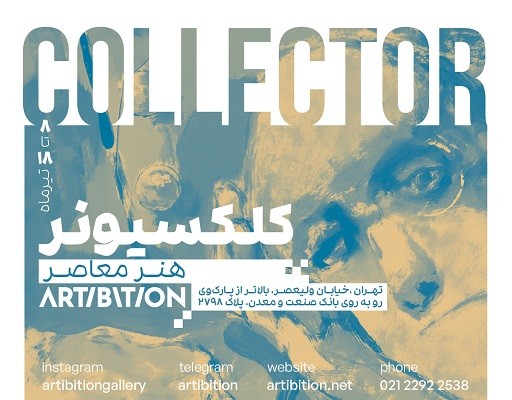
The group exhibition "Contemporary Collector" with works of well-known visual art artists will be displayed on Friday, July 8, at Artibishan Gallery.
Farshid Maleki (b. 1943, Tehran) is a painter from the second generation of Iranian modern artists. He became interested in painting from childhood and began his formal art education at the Kamal-ol-Molk Art School. In 1969, he completed his B.A. in Graphic Design at the Faculty of Decorative Arts (now University of Art, Tehran). Shortly after, he traveled to London for a three-month study program organized by the Iranian National Television to gain familiarity with British television, and he continued his art studies there. Around the time of the 1979 Revolution, he earned his postgraduate degree in Painting from the University of Reading, UK, and subsequently returned to Iran. Maleki has taught at Farabi University, Alzahra University, and Islamic Azad University, and was a faculty member at the University of Art in Tehran. He has exhibited widely in Iran and abroad, collaborating with notable Iranian galleries such as Golestan, Arya, Hoor, Emkan, and Tarahan Azad. Invited by Rouin Pakbaz, he joined Talare Iran (Iran Gallery) and held his first solo exhibition there in 1968. His second solo exhibition was presented at Ghandriz Gallery in 1973. Critic Marcos Grigorian (Eslahoss?) compared his works of that period to African totems in an article for Kayhan. In later years, Maleki abandoned totemic imagery and distanced himself from currents aligned with national identity and “Neo-Traditionalism.” Unlike many of his contemporaries, his works lack the conventional borrowings from Iranian artistic heritage. Maleki began his career with abstract works, experimenting with unfamiliar materials and techniques. What has brought him wide recognition in more recent years, however, is his turn toward figurative and highly personal painting, which has also been well received by the public. In these works, he presents figures from multiple viewpoints within a single composition, challenging our perception of the horizon line, and juxtaposes human forms with animals to articulate his worldview and themes. Art critic Iman Afsarian describes Maleki as “one of the few Iranian painters who has boldly changed his style multiple times.” Fereydoun Ghafari, in discussing the contrast between Maleki’s early and late periods, states: “Perhaps one could say that Maleki’s later drawings correspond more to his inner needs, without any consideration of external demands. Some artists work purely from within, regardless of prevailing trends, while others align themselves more with external conditions. In Maleki’s case, one can see this very difference—or shift in perspective—between his early and recent works.”
1943 – Born in Tehran
1968 – Solo painting exhibition, Ghandriz Hall, Tehran
1973 – Solo painting exhibition, Ghandriz Hall, Tehran
1974 – Solo painting exhibition, Tehran Gallery, Tehran
1984 – Solo painting exhibition, Goethe-Institut, Tehran
1989 – Solo painting exhibition, Sheikh Gallery, Tehran
1991 – Solo painting exhibition, Golestan Gallery, Tehran
1993 – Solo painting exhibition, Arya Gallery, Tehran
1993 – Solo painting exhibition, Golestan Gallery, Tehran
1994 – Solo painting exhibition, Arya Gallery, Tehran
1999 – Solo drawing exhibition, Arya Gallery, Tehran
2003 – Solo drawing exhibition, Haft Samar Gallery, Tehran
2005 – Solo painting exhibition, Azad Gallery, Tehran
2005 – Solo painting exhibition, Dubai Painting Exhibition, B.21 Gallery, United Arab Emirates
2007 – Solo painting and drawing exhibition, Haft Samar Gallery, Tehran
2009 – Solo exhibition, Without Initiative, Isabelle van den Eynde Gallery, Dubai
2011 – Solo exhibition, Suspension, Tarahan Azad Gallery, Tehran
2011 – Solo exhibition, The One Who Came and Disappeared, Isabelle van den Eynde Gallery, Dubai
2012 – Solo exhibition, Tragedy and Comedy, or Something In-Between, Tarahan Azad Gallery, Tehran
2013 – Solo exhibition, On Black Paper: Colored Drawings of Farshid Maleki, Tarahan Azad Gallery, Tehran
2014 – Solo exhibition, Paintings by Farshid Maleki, Hoor Gallery, Tehran
2016 – Solo exhibition, Paintings by Farshid Maleki, Hoor Gallery, Tehran
2018 – Solo exhibition, Painting Exhibition, Hoor Gallery, Tehran
2019 – Solo exhibition, Painting Exhibition, Hoor Gallery, Tehran
2020 – Solo exhibition, Farshid Maleki Painting Exhibition, Hoor Gallery, Tehran
2020 – Solo exhibition, Farshid Maleki Portfolio, Rezvan Projects, Tehran
2021 – Solo exhibition, I Am Human, I Have Suffered, I Have Ended Up Here, Azad Gallery, Tehran
2021 – Solo exhibition, Wall, Tarahan Azad Gallery, Tehran
2022 – Solo exhibition, Paintings by Farshid Maleki, Hoor Gallery, Tehran

The group exhibition "Contemporary Collector" with works of well-known visual art artists will be displayed on Friday, July 8, at Artibishan Gallery.